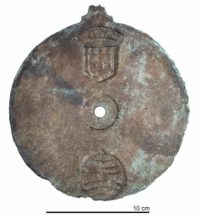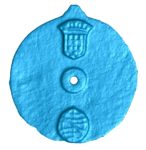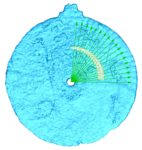 One of the objects found in the excavation of the shipwreck from Vasco da Gama’s second voyage to India discovered off the coast of Oman in 2014 has been identified as an astrolabe, a marine navigational tool that could calculate latitude based on the position of the sun. Marine astrolabes are very rare with only 108 of them known to exist. This one is the oldest of them all.
One of the objects found in the excavation of the shipwreck from Vasco da Gama’s second voyage to India discovered off the coast of Oman in 2014 has been identified as an astrolabe, a marine navigational tool that could calculate latitude based on the position of the sun. Marine astrolabes are very rare with only 108 of them known to exist. This one is the oldest of them all.
When divers discovered the copper alloy disc in the debris field of the Esmeralda, a ship in da Gama’s fleet that sank in 1503, there was no direct evidence on its surface of it being an astrolabe. All that was clearly visible were raised decorations — a Portuguese royal coat of arms and the esfera armilar (armillary sphere), King Manuel I’s personal emblem — which identified it as Portuguese. There is no writing on the disk and no other artifacts that might shed light on some aspect of the disk (age, purpose) were discovered near the find spot.
 There were hints of its true function, however. Its round shape, its dimensions (17.5cm in diameter, 1.5mm thick), the hole in the center and the remains of what was likely a suspension bracket at the top so it could be worn as around the neck suggested it might be a very early astrolabe. Age of Discovery marine astrolabes were generally heavier and ballasted so they could hang plumb for optimal calculations even on a swaying, bobbing, rearing ship in heavy winds.
There were hints of its true function, however. Its round shape, its dimensions (17.5cm in diameter, 1.5mm thick), the hole in the center and the remains of what was likely a suspension bracket at the top so it could be worn as around the neck suggested it might be a very early astrolabe. Age of Discovery marine astrolabes were generally heavier and ballasted so they could hang plumb for optimal calculations even on a swaying, bobbing, rearing ship in heavy winds.
The Esmeralda disk doesn’t have the weight or cutouts common to the more typical examples from the 16th century. Because of the significant design differences, the marine archaeologists who examined it could not compare it to its brethren to confirm whether it even was an astrolabe. They’d need navigational markings to know for sure and while they thought there might be some very faint lines on the back, they were barely visible to the naked eye.
 Into that breach stepped Professor Mark Williams at WMG, University of Warwick, and his trusty laser scanner. The high-tech scan and 3D model created from the data revealed that there were indeed markings on the disk, lines etched along the edges, each line exactly five degrees apart. Those are the navigational markings the team was looking for. Sailors used them to measure the height of the noonday sun to calculate their latitude on long voyages through wide-open seas. Vasco da Gama’s second voyage to India in which the Esmeralda was lost took his fleet down all of west Africa, across the Cape of Good Hope, up the east coast to Mombasa and then east to India. It took years and was extremely dangerous. A tool that could give you some idea of where in the dickens you were was invaluable on journeys of such enormous scale.
Into that breach stepped Professor Mark Williams at WMG, University of Warwick, and his trusty laser scanner. The high-tech scan and 3D model created from the data revealed that there were indeed markings on the disk, lines etched along the edges, each line exactly five degrees apart. Those are the navigational markings the team was looking for. Sailors used them to measure the height of the noonday sun to calculate their latitude on long voyages through wide-open seas. Vasco da Gama’s second voyage to India in which the Esmeralda was lost took his fleet down all of west Africa, across the Cape of Good Hope, up the east coast to Mombasa and then east to India. It took years and was extremely dangerous. A tool that could give you some idea of where in the dickens you were was invaluable on journeys of such enormous scale.
The precise date of manufacturer is unknown at this time, but it’s decades older than the any other marine astrolabe we know of.
[Expedition leader David] Mearns said: “We know it had to have been made before 1502, because that’s when the ship left Lisbon and Dom Manuel didn’t become King until 1495, and this astrolabe wouldn’t have carried the emblem of the King unless he was King.
“I believe it’s probably fair to say it dates roughly to between 1495 to 1500. Exactly what year we don’t know – but it is in that narrow period.”
He added: “It rolls back this history by at least 30 years – it adds to evolution, it adds to the history, and hopefully astrolabes from this period can be found.”
Here’s a video capturing the exact moment the astrolabe was dug out of the sand.
This one from 1495 to 1500 AD is earliest known marine astrolabe ? What happened to the ones from the two millennia before 1500 ? :confused:
The headline has been bothering me too. Does it all turn on “marine” astrolabe or did some editor not do his homework?
Indeed, the focus here seems to be on the ‘maritime‘ aspect, and indeed only a few of those seem to have survived. The ‘Rosa dos Ventos’ (‘do Infante D. Henrique’, i.e. Prince Henry the Navigator) in Sagres, I reckon, was not at all a ‘sun dial’ or whatever, but a means to ‘labe’ the ‘astros’, similar to what ‘Stonehenge’ might have been, even if the idea behind it back then was certainly a different one.
When referring to the ‘Uluburun’ Shipwreck from the late 14th century BC , particularly their list of cargo, they definitely did sea trade, but not necessarily open sea travel. However, it might be fair to assume that, let’s say, around 1000 AD, Asian traders in the Indian Ocean or Vikings -in combination with their ‘navigation crystal’- used something similar to an astrolabe. – Besides, ‘de Gama’ ? – Wouldn’t it be ‘da Gama’ ?
——————
PS: I have been to his place of birth in Sines, as well as his resting place in Lisbon, I even have seen Lagos and the beaches in Sines. Unfortunately, however, I found no further hints on the ‘maritime astrolabe’ issue 😉
Re an earlier topic:
https://www.theguardian.com/culture/2017/oct/26/galloway-viking-hoard-acquired-by-national-museums-of-scotland
Marina, yes indeed. His name was Vasco da Gama in Portuguese.
Doesn’t compare very well to the Antikythera Mechanism does it?